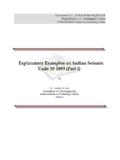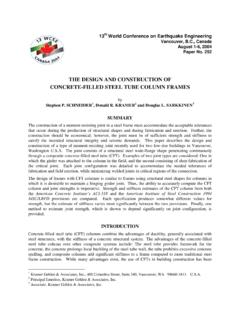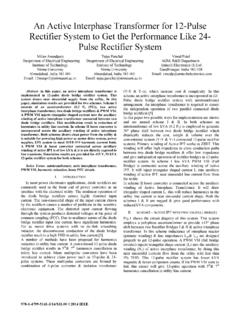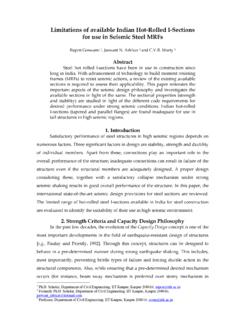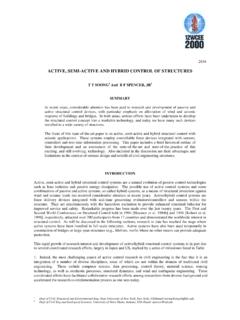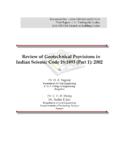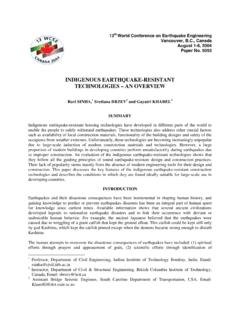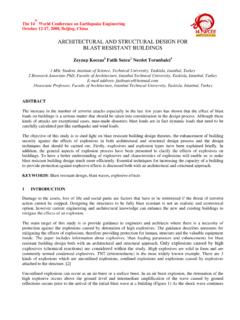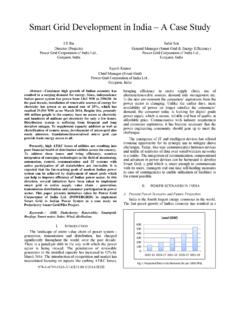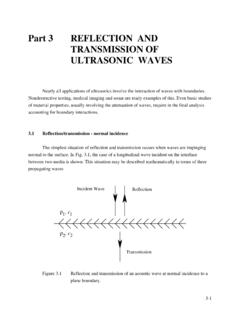Transcription of IS 13311-1 (1992): Method of Non-destructive testing of ...
1 Disclosure to Promote the Right To InformationWhereas the Parliament of India has set out to provide a practical regime of right to information for citizens to secure access to information under the control of public authorities, in order to promote transparency and accountability in the working of every public authority, and whereas the attached publication of the Bureau of Indian Standards is of particular interest to the public, particularly disadvantaged communities and those engaged in the pursuit of education and knowledge, the attached public safety standard is made available to promote the timely dissemination of this information in an accurate manner to the public. ! $ ' + - Satyanarayan Gangaram Pitroda Invent a New India Using Knowledge 0 1 ' 5 Jawaharlal Nehru Step Out From the Old to the New 1 + , 1 + Mazdoor Kisan Shakti Sangathan The Right to Information, The Right to Live !
2 > 0 B Bhart hari N ti atakam Knowledge is such a treasure which cannot be stolen Invent a New India Using Knowledge IS 13311-1 (1992): Method of Non-destructive testing ofconcret, Part 1: Ultrasonic pulse velocity [CED 2: Cementand Concrete]IS13311 (Part1 ):i992 vITamT% Indian Standard Non-destructive testing OF CONCRETE - METHODS OF TEST PART 1 ULTRASONIC PULSE VELOCITY First Reprint SEPTEMBER 1996 UDC 666*972*620* @ BIS, : 1992 BUREAU OF INDIAN STANDARDS MANAK BHAVAN, 9 BAHADUR SHAH ZAFAR MARO NEW DELHI 110002 Junuury 1992 Price Group 4 Cement and Concrete Sectional Committee, CED 2 FOREWORD This Indian Standard was adopted by the Bureau of Indian Standards, after the draft finalized by the Cement and Concrete Sectional Committee had been approved by the Civil Engineeflng Division Council.
3 There are occasions when the various performance ,characteristics of concrete in a structure are required to be assessed. In most of the cases, an estimate of strength of concrete in the structure is needed, although parameters like overall quality, uniformity, etc, also become important in others. The various methods that can be adopted for in-situ assessment of strength properties of concrete depend upon the particular aspect of the strength in question. For example, if the load-carrying capacity of a structural ensemble is to be assessed, carrying out a full-scale load test as per IS 456 : 1978 Code of practice for plain and reinforced concrete ( thirdrevision ) or IS 1343 : 1980 Code of practice for prestressed concrete (first revision ) is the most direct way; on the other hand when the actual compressive strength of concrete in the structure is to be measured, core testing as per IS 516 : 1959 Method of test for strength of concrete is more reliable.
4 However, both these methods are relatively cumbersome and the latter Method may leave the structure damaged locally in some cases. Use is, therefore, made of suitable non- destructive tests, which not only provide an estimate of the relative strength and overall quality of concrete in the structure but also help in deciding whether more rigorous tests like load test- ing or core drilling at selected locations are required. There are va rious such Non-destructive testing methods which can be broadly classified as those which measure the overall quality of concrete, for example dynamic or vibration methods like resonance frequency and ultrasonic pulse velocity tests and those which involve measurement of parameters like surface hardness, rebound, penetration, pull-out strength, etc, and are believed to be indirectly related to the compressive strength of concrete.
5 In addition, radiographic, radiometric, nuclear, magnetic and electrical methods are also available. Since such Non-destructive tests are at best indirect methods of monitoring the particulars, characte- ristic of concrete and the measurements are influenced by materials, mix and environmental factors, proper interpretation of the results calls for certain degree of expertise. It is more so, when the data on the materials and mix proportions used in the construction are not available, as is often the case. In view of the limitations of the methods for predicting the strength of concrete in the structure it is preferable that both ultrasonic pulse velocity and rebound hammer methods given in Part 2 of the standard are used in combination to alleviate the errors arising out of influence of material, mix and environmental parameters on the respective measurements.
6 Relationships between pulse velocity, rebound number and compressive strength of concrete are obtained by multiple regression of the measured values on laboratory test specimens. However, this approach has the limitation that the correlations are valid only for the materials and mix proportions used in trials. The intrinsic difference between the laboratory test specimens and in-situ con- crete, for example, surface texture, moisture condition, presence of reinforcement, etc, also affect the accuracy of results. The correlation is valid only within the range of values of pulse velocity rebound number and compressive strength employed and any extrapolation beyond these is open to question. Because of the above limitations, the combined use of these two methods is made in another way. In this, if the quality of concrete is assessed to be excellent or good by pulse velocity Method , only then the compressive strength is assessed from the rebound manner indices and this is taken as indicative of strength of concrete in the entire cross-section of the concrete member.
7 When the quality assessed is medium , the estimation of compressive strength by rebound indices is extended to the entire mass only on the basis of other colateral measurements, for example, strength of site concrete cubes, cement content in the concrete or core testing . When the quality of concrete is doubtful, no assessment of concrete strength is made from rebound indices. ( Continued on third Cover ) Indian Standard NON-DESTRUCTIVETESTINGOFCONCRETE METHODS-OF TEST PART 1 ULTRASONIC PULSE VELOCITY 1 SCOPE This standard covers the object, principle, apparatus and test procedure of ultrasonic pulse velocity test Method . In addition, influence of test conditions and some general guidance on the interpretation of test results are also given. NOTE - In view of the limitations of each Method of Non-destructive testing of concrete, it is essen!
8 Ial that the results .of tests obtained by one Method should be complimented by other tests and each Method should be aqopted very carefully. 2 OBJECT The ultrasonic pulse velocity Method could be used to establish: 4 b) cl 4 e) the homogeneity of the concrete, the presence of cracks, voids and other imperfections, changes in the structure of the concrete which may occur with time, the quality of the concrete in relation to standard requirements, the quality of one element of concrete in relation to another, and f) the values of dynamic elastic modulus of the concrete. 3 PRINCIPLE The ultrasonic pulse is generated by an electroacoustical transducer. ,When the pulse is induced into the concrete from a transducer, it undergoes multiple reflections at the boundaries of the differ&t material phases within the con- crete. A complex system of stress waves is developed which includes longitudinal ( comp- ressional ), shear ( transverse ) and surface ( rayleigh ) waves.
9 The receiving transducer detects the onset of the longitudinal waves, which is the fastest. Because the velocity of the pulses is almost independent of the geometry of the material through which they pass and depends only on its elastic properties, pulse velocity Method is a convenient technique for investigating structural concrete. 1992 The underlying principle of assessing the quality of concrete is that comparatively higher velo- cities are obtained when the quality of concrete in terms of density, homogeneity and uniformity is good. In case of poorer quality, lower velo- cities are obtained. If there is a crack, void or flaw inside the concrete which comes in the way of transmission of the pulses, the pulse strength is attenuated and it passes around the discon- tinuity, thereby making the path length longer. Consequently, lower velocities are obtained.
10 The actual pulse velocity obtained depends primarily upon the materials and mix propor- tions of concrete. Density and modulus of elasticity of aggregate also significantly affect the puise velocity. 4 APPARATUS The apparatus for ultrasonic pulse velocity measurement shall consist of the following: a) Electrical pulse generator, b) Transducer - one pair, c) Amplifier, and d) Electronic timing device. Transducer Any suitable type of transducer operating with- in the frequency Lange of 20 kHz to 150 kHz ( see Table 1 ) may be used. Piezoelectric and magneto-strictive types of transducers may be used, the latter being more suitable for the lower part of the frequency range. Table 1 Natural Frequency of Transducers for Different Path Lengths Path Length Natural Frequency Minimum Transverse of Troasdncer Dimensions of Members (mm) +JQ (mm) up to 500 150 25 500-700.
